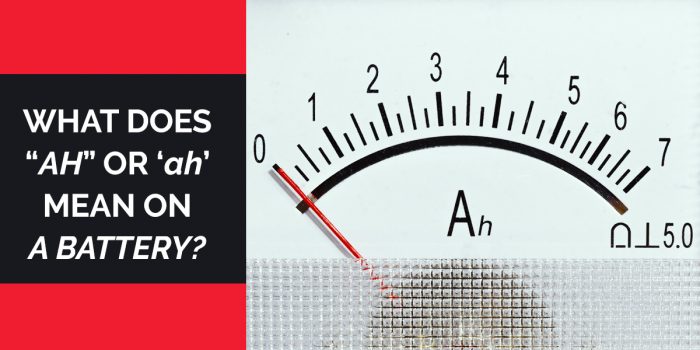Batteries, those ubiquitous powerhouses, often sport cryptic alphanumeric designations. Among them, “Ah” or “AH” frequently appears, leaving many consumers in a state of befuddlement. What precisely does this seemingly arcane notation signify? The answer, while technically straightforward, unlocks a deeper understanding of battery capacity and performance.
Ah stands for Ampere-hour, a unit of electric charge. Think of it as the total reservoir of electrical energy a battery can discharge over a specific period. More formally, an ampere-hour represents the quantity of electricity equivalent to one ampere flowing for one hour. The higher the Ah rating, the greater the battery’s capacity to deliver current over time. This concept is foundational to grasping battery longevity and suitability for various applications.
Let’s delve into the practical ramifications of Ampere-hour ratings.
Understanding Capacity and Discharge Rate: A battery rated at 10Ah, theoretically, can supply a current of 1 ampere for 10 hours. Alternatively, it could provide 2 amperes for 5 hours. The inverse relationship between current draw and discharge duration is critical. However, realize that this is a theoretical maximum. Real-world factors, like temperature and discharge rate, influence actual performance.
Differentiating Deep Cycle vs. Starter Batteries: Starter batteries, commonly found in automobiles, prioritize high current output for short bursts to crank the engine. They’re designed for rapid discharge and immediate recharge. Deep cycle batteries, conversely, are engineered for sustained, lower current discharge over extended periods. These are frequently used in applications like solar energy storage, recreational vehicles, and electric mobility devices. A higher Ah rating is more critical for deep cycle applications, ensuring prolonged operation between charges.
The Role of Voltage: Ah alone doesn’t tell the whole story. Voltage, measured in volts (V), represents the electrical potential difference. The total energy stored in a battery is a function of both Ah and voltage. Watt-hours (Wh), calculated by multiplying Ah by voltage, provide a more comprehensive metric for comparing battery energy storage capabilities. A 12V 10Ah battery, for instance, stores 120Wh of energy.
Impact on Device Run Time: For portable electronic devices, the Ah rating directly influences runtime. A smartphone battery with a 3Ah rating will generally last longer than one with a 2Ah rating, assuming similar power consumption profiles. However, software optimization, screen brightness, and processor load significantly impact actual usage time. This is why identical devices with the same Ah rating can exhibit markedly different battery lives.
Calculating Battery Life: Determining the estimated runtime of a device powered by a battery with a known Ah rating involves a straightforward calculation, though some nuance is required. First, ascertain the device’s power consumption in watts (W). Divide this value by the battery’s voltage (V) to obtain the current draw in amperes (A). Finally, divide the battery’s Ah rating by the current draw to estimate the runtime in hours. Keep in mind that these calculations are based on idealized conditions, and external variables introduce deviations.
Temperature Effects: Ambient temperature profoundly influences battery performance. Lower temperatures typically reduce battery capacity, leading to diminished Ah availability. Conversely, elevated temperatures can accelerate battery degradation and shorten lifespan. Operating batteries within their specified temperature range is paramount for optimal performance and longevity.
C-Rate Considerations: The C-rate is a measure of the rate at which a battery is discharged relative to its maximum capacity. A 1C discharge rate means the battery is discharged at a rate that will fully deplete it in one hour. Higher C-rates can strain the battery, potentially shortening its lifespan and reducing its effective Ah capacity. Adhering to the manufacturer’s recommended discharge rates is crucial for preserving battery health.
Storage Impacts on Ah: Prolonged storage can lead to self-discharge, gradually reducing the battery’s Ah capacity. Proper storage practices, such as maintaining a partial state of charge and storing batteries in cool, dry environments, can minimize self-discharge and extend shelf life. Regularly checking and topping off the charge of stored batteries is advisable.
Battery Chemistry Variations: Different battery chemistries, such as lithium-ion (Li-ion), nickel-metal hydride (NiMH), and lead-acid, exhibit varying characteristics in terms of energy density, discharge rate, and lifespan. Li-ion batteries, for instance, generally offer higher energy density and lower self-discharge rates compared to lead-acid batteries. Selecting the appropriate battery chemistry for a specific application is crucial for optimizing performance and cost-effectiveness. Each chemistry has a different voltage too and the Ah rating has to be considered with this voltage.
In conclusion, understanding the Ah rating of a battery provides crucial insights into its capacity, discharge characteristics, and suitability for various applications. While Ah alone is not the sole determinant of battery performance, it serves as a fundamental metric for evaluating its ability to deliver power over time. Combining this knowledge with an awareness of voltage, C-rate, temperature effects, and battery chemistry enables informed decision-making when selecting and utilizing batteries. The next time you encounter “Ah” on a battery label, you’ll possess the insight to decipher its true meaning.









Leave a Comment